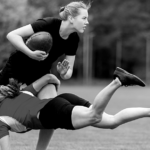The movement demands of all sports are specific in nature. However, most sports require some form of change of direction, with varying levels of approach speed, body position, frequency, angle of direction, etc. The improvement and optimisation of change of direction performance is vital within strength and conditioning practice, and requires a thorough understanding of what optimal change of direction looks like (mechanically) and how it can be enhanced. This not only includes the programming of actual change of direction practice, but rather an integrated -training mode approach involving multiple training methods.
When executing a rapid change of direction, an athlete is required to apply large ground reaction forces to propel themselves within the new desired direction (in conjunction with Newtonian mechanics). However, the time scale in which to apply such force is severely limited as the athlete is in locomotion and is therefore constrained to the duration of the foot contact when the force is being applied. Therefore, an athlete requires adequate force and power generating capabilities to enable them to effectively change direction.
Maximal Strength
The role of traditional strength training methods and change of direction performance has previously been debated within sport science, with the effectiveness of vertical plane strength based methods being called into question. However, a literature review completed by Watts (2015) concluded that maximal strength is a significant performance determinant within change of direction performance. Spiteri et al (2014) previously demonstrated that change of direction performance is positively correlated to maximal strength in conjunction with other strength qualities (isometric, concentric and eccentric strength).
Keiner et al (2014) reported similar findings when investigating the correlations between maximal strength and change of direction performance and the long-term effects of maximal strength training on the ability to effectively change direction. The authors reported that moderate to high correlations where present between maximal front and back squat performance and change of direction capabilities. Furthermore, the authors also reported that two years’ worth of strength training in elite youth soccer players (13 to 18 years of age) significantly improved change of direction performance. Nimphius et al (2010) reported consistent correlations between maximal strength and change of direct ability over the course of a playing season in softball athletes. These findings demonstrate the importance of maximal strength training and the improvement of change of direction ability, and why improving maximal strength and peak force capabilities in conjunction with other key qualities (power, RFD, optimal technique, etc.) is needed in athletes that require change of direction performance.
Unilateral Strength
As change of direction is both unilateral and multi-directional in nature, coaches need to ensure that some of the applied training modes closely resemble the kinematics and kinetics of change of direction performance. For example, unilateral squat variations (e.g. split squats, lunges, loaded step ups, etc.) more closely mimic the kinematic demands of unilateral based movements. Loaded movements that applying towing devices such as lateral sled drags effectively replicate the mechanics of lateral cutting movements. Such training modes can be programmed in combination with lateral based plyometrics (e.g. lateral and diagonal bounds), unilateral based plyometrics (e.g. multi-uni lateral hops, etc.) and other training methods that enhance stretch shortening capabilities and tendon stiffness within a frontal plane.
Plyometrics
Plyometric interventions aimed at improving change of direction performance (by increasing power production and musculotendon stiffness) have been most effective when the chosen plyometric modes have most closely replicated the kinematics of change of direction performance (e.g. movement within a frontal plane, lower centre of mass, etc.). McCormick et al (2016) investigated the effects of frontal plane vs sagittal plane plyometric training on change of direction performance in basketball athletes, and found that the frontal plane based plyometric intervention was more effective at improving change of direction performance. Brughelli et al (2008) reported similar findings, suggesting that horizontal jump based training and lateral jump training (in conjunction with actual change of direction practice) was most effective at improving change of direction performance.
Therefore, performance programs aimed at improving change of direction performance should include not only change of direction practice, but also maximal strength and plyometric based training methods. Lastly, strength and conditioning coaches should ensure that not the selected exercise methods occur within a sagittal plane, but rather involve frontal plane based plyometrics and unilateral strength training modes.
Watts, D. (2015). A brief review on the role of maximal strength in change of direction speed. Journal of Australian Strength and Conditioning. 23(2), pp: 100-108.
Brughelli, M. Cronin, J. Levin, G. Chaouachi, A. (2008). Understanding Change of Direction Ability in Sport: A Review of Resistance Training Studies. Sports Medicine. 38(12), pp: 1045-1063.
McCormick, B, T. Hannon, J, C. Newton, M. Shultz, B. Detling, N. Young, W, B. (2016). The Effects of Frontal- and Sagittal-Plane Plyometrics on Change-of-Direction Speed and Power in Adolescent Female Basketball Players. International Journal of Sports Physiology and Performance. 11(1), pp: 102–107.
Spiteri, T. Nimphius, S. Hart, N, H. Specos, C. Sheppard, J, M. Newton, R, U. (2014). Contribution of strength characteristics to change of direction and agility performance in female basketball athletes. Journal of Strength and Conditioning Research. 28(9), pp: 2415–2423.
Keiner, M. Sander, A. Wirth, K. Schmidtbleicher, D. (2014). Long-term strength training effects on change-of-direction sprint performance. Journal of Strength and Conditioning Research. 28(1), pp: 223–231.
Nimphius, S. McGuigan, M, R. Newton, R, U. (2010). Relationship between strength, power, speed and change of direction performance of female softball players. Journal of Strength and Conditioning Research. 24(4), pp: 885-895.


